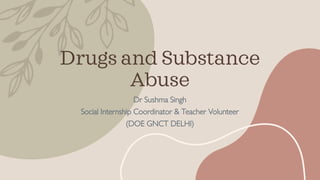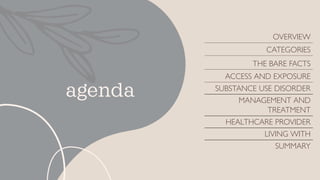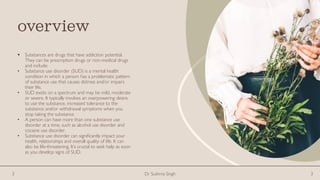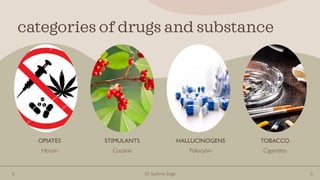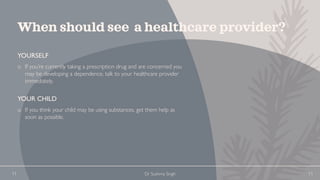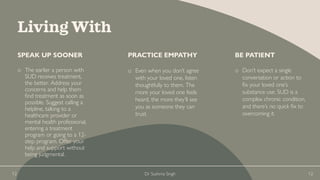Presentation on Drugs and Substance Abuse by Dr Sushma Singh
- 1. Drugs and Substance Abuse Dr Sushma Singh Social Internship Coordinator & Teacher Volunteer (DOE GNCT DELHI)
- 2. agenda OVERVIEW CATEGORIES THE BARE FACTS ACCESS AND EXPOSURE SUBSTANCE USE DISORDER MANAGEMENT AND TREATMENT HEALTHCARE PROVIDER LIVING WITH SUMMARY
- 3. overview ? Substances are drugs that have addiction potential. They can be prescription drugs or non-medical drugs and include: ? Substance use disorder (SUD) is a mental health condition in which a person has a problematic pattern of substance use that causes distress and/or impairs their life. ? SUD exists on a spectrum and may be mild, moderate or severe. It typically involves an overpowering desire to use the substance, increased tolerance to the substance and/or withdrawal symptoms when you stop taking the substance. ? A person can have more than one substance use disorder at a time, such as alcohol use disorder and cocaine use disorder. ? Substance use disorder can significantly impact your health, relationships and overall quality of life. It can also be life-threatening. It¡¯s crucial to seek help as soon as you develop signs of SUD. 3 Dr Sushma Singh 3
- 4. categories
- 5. categories of drugs and substance OPIATES STIMULANTS HALLUCINOGENS TOBACCO Heroin Cocaine Psilocybin Cigarettes 5 Dr Sushma Singh 5
- 6. THE BARE FACTS ¡°factsheet¡± 6 Dr Sushma Singh 6
- 7. the bare facts DEATHS The harmful use of alcohol results in 3.3 million deaths each year. AVERAGE CONSUMPTION On average every person in the world aged 15 years or older drinks 6.2 litres of pure alcohol per year. PER YEAR CONSUMPTION Less than half the population (38.3%) actually drinks alcohol, this means that those who do drink consume on average 17 litres of pure alcohol annually. DISORDERS At least 15.3 million persons have drug use disorders. CONNECTION WITH HIV Injecting drug use reported in 148 countries, of which 120 report HIV infection among this population. 7 Dr Sushma Singh 7
- 8. Access and exposure Access to substances is a particularly significant environmental risk factor. Factors that increase the extent of exposure and the opportunity for substance use include: 1 Use of substances by a member of your household 2 Use of substances by your peers. 3 Being prescribed a drug that can be misused, such as opioids or stimulants 8 Dr Sushma Singh 8
- 9. substance use disorder OPIOID USE POST-TRAUMATIC STRESS PANIC GENERALIZED ANXIETY disorder disorder disorder disorder DEPRESSION BORDERLINE PERSONALITY BIPOLAR ATTENTION-DEFICIT/HYPERACTIVITY disorder disorder disorder ADHD disorder
- 10. Management and Treatment effective treatments are available for substance use disorder. treatment is highly individualized ¡ª one person may need different types of treatment at different times. treatment for SUD often requires continuing care to be effective, as SUD is a chronic condition with the potential for both recovery and relapse. as people with SUD often have co- occurring mental health conditions, treating them together rather than separately is generally better. main forms of treatment include: ? detoxification. ? cognitive and behavioural therapies. ? medication-assisted therapies. types of treatment settings, including: ? outpatient counselling. ? intensive outpatient treatment. ? inpatient treatment. ? long-term therapeutic communities, such as sober living communities.
- 11. When should see a healthcare provider? YOURSELF o If you¡¯re currently taking a prescription drug and are concerned you may be developing a dependence, talk to your healthcare provider immediately. YOUR CHILD o If you think your child may be using substances, get them help as soon as possible. 11 Dr Sushma Singh 11
- 12. Living With SPEAK UP SOONER o The earlier a person with SUD receives treatment, the better. Address your concerns and help them find treatment as soon as possible. Suggest calling a helpline, talking to a healthcare provider or mental health professional, entering a treatment program or going to a 12- step program. Offer your help and support without being judgmental. PRACTICE EMPATHY o Even when you don¡¯t agree with your loved one, listen thoughtfully to them. The more your loved one feels heard, the more they¡¯ll see you as someone they can trust. BE PATIENT o Don¡¯t expect a single conversation or action to fix your loved one¡¯s substance use. SUD is a complex chronic condition, and there¡¯s no quick fix to overcoming it. 12 Dr Sushma Singh 12
- 13. summary Drugs and Substance Abuse: ? overview ? categories ? the bare facts ? access and exposure ? substance use disorder ? management and treatment ? healthcare provider ? living with 13 Dr Sushma Singh 13
- 14. thank you Director of Education GNCT Delhi Ladli Foundation Principal All Befeficiaries

